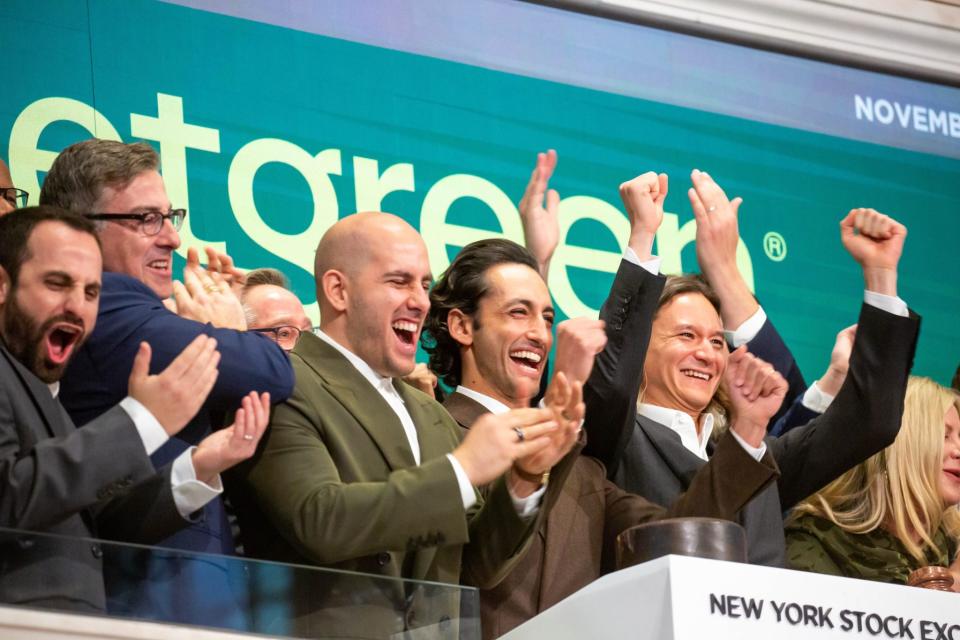Sweetgreen beats ‘sad desk salad’ vibes to soar above fast-food competitors. It can thank fancy foods, high prices—and robots

Sweetgreen is proving it’s no sad desk salad company. By leaning into robots, higher prices, and its healthier-than-most reputation, the upscale fast-casual chain just posted an expectation-defying first quarter as it inches toward profitability.
The company reported Thursday $157.9 million in its first quarter revenue, a 26% increase from its $135.1 million a year ago. Its share price has surged almost 250% in the past six months, to about $32. While it has yet to turn a profit in its 17 years, Sweetgreen narrowed its net loss to $26.1 million, compared to $33.7 million in last year’s first quarter.
Founded in 2007 by Georgetown University alums looking for fast, nutritious food, Sweetgreen has become the go-to lunch spot of the young corporate world, wooing Gen Z and millennial professionals to its $20 salads and bowls through the promise of healthy ingredients and brand deals with celebrities like tennis star Naomi Osaka and influencer Noah Beck.
In recent months, the chain has rolled out a raft of changes, including eliminating the use of seed oils in favor of avocado and olive oils to align with health trends; introducing grass-fed steak on its menu for the first time to boost dinner sales, and subsequently raising menu prices—adding beef to your salad or grain bowl will cost an additional $6.45.
Sweetgreen is among the ranks of other health-branded chain restaurants like Cava and Chipotle which have soared thanks to wide profit margins and general interest in fast-casual dining. Meanwhile, fast-food favorites like McDonald’s and Wendy’s have struggled to retain their audience of customers looking for affordability, as once-affordable Big Mac meals creep above $18.
But Sweetgreen can also thank robot automation for its auspicious start to the year. The technology, internally called Infinite Kitchen, can shoot greens, beans, and other toppings into customers’ bowls. So far, it’s in a handful of the chain’s suburban locations and is proving very profitable: Stores with the tech had a first-quarter margin of 28%—10 percentage points higher than the company-wide average.
According to Neman, the implementation of Infinite Kitchen has helped the company increase order throughput, accuracy, and portion consistency, as well as retain more employees. The company plans to open seven more Infinite Kitchen locations in 2024, as well as retrofit three or four Sweetgreen locations with the technology, starting in New York.
“Looking ahead, we have a massive opportunity to bring real food to more communities and disrupt the industry with the rollout of the Infinite Kitchen,” Neman said.
Industry, disrupted
Sweetgreen first began investing in Infinite Kitchen in spring 2023, piloting the automation in two suburban locations. The investment, a hefty $500,000 per store for the technology’s development and installation, saw near immediate returns. In Sweetgreen’s 2023 fourth quarter, the company reported 10% greater ticket sales in Infinite Kitchen locations compared to similar restaurants in the surrounding market.
If Sweetgreen’s success with Infinite Kitchen is any indication, fast-casual chains are surely more likely to start putting more trust into robot counterparts. In October, Chipotle announced its partnership with Hyphen, a digital platform to automate the creation of salads and bowls, which make up 65% of the chain’s orders.
“Our goal is to have the automated digital makeline be the centerpiece of all our restaurants' digital kitchens,” Curt Garner, Chipotle’s chief customer and technology officer, said.
The trend of entrusting robots to make fast food is part of an effort to retain employees and save on hefty labor costs, which make up 36% of restaurants’ expenditures. Almost all restaurants have reported labor costs as a concern, according to the National Restaurant Association’s 2024 State of the Restaurant Industry report. With fast-food worker turnover high—and with replacing employees costing restaurants $1,500 per departing employee—chains are eager to retain their workforce. Increased restaurant automation can help relieve employees of tedious tasks in addition to speeding up order fulfillment, taking pressure off busy workers, Bank of America analyst Sara Senatore argued.
“In many cases, this reallocation benefits the customers, but it also benefits the employee,” she told Fortune in March.
This story was originally featured on Fortune.com

 Yahoo Finance
Yahoo Finance 